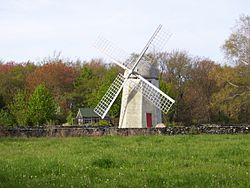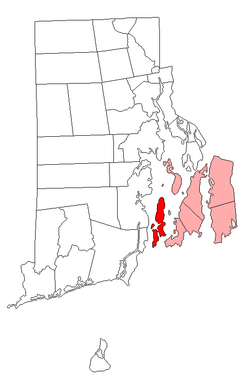Jamestown, Rhode Island facts for kids
Quick facts for kids
Jamestown, Rhode Island
|
|
|---|---|

Jamestown Windmill, built in 1787
|
|

Location of Jamestown in Newport County, Rhode Island
|
|
| Country | United States |
| State | Rhode Island |
| County | Newport |
| Government | |
| • Type | Council - Administrator form of government |
| Area | |
| • Total | 35.3 sq mi (91.5 km2) |
| • Land | 9.7 sq mi (25.1 km2) |
| • Water | 25.6 sq mi (66.4 km2) |
| Elevation | 62 ft (19 m) |
| Population
(2020)
|
|
| • Total | 5,559 |
| • Density | 574/sq mi (221.5/km2) |
| Time zone | UTC−5 (Eastern (EST)) |
| • Summer (DST) | UTC−4 (EDT) |
| ZIP code |
02835
|
| Area code(s) | 401 |
| FIPS code | 44-36820 |
| GNIS feature ID | 1220061 |
Jamestown is a small town in Rhode Island, located in Newport County. In 2020, about 5,559 people lived there. Most of Jamestown is on Conanicut Island, which is the second-largest island in Narragansett Bay. It also includes two smaller, uninhabited islands called Dutch Island and Gould Island.
Contents
Geography of Jamestown
Jamestown covers about 35 square miles (91.5 square kilometers). Most of this area, about 72.55%, is water. The land area is around 9.7 square miles (25.1 square kilometers).
Rhode Island Route 138 is the main highway in Jamestown. It connects the island to North Kingstown in the west using the Jamestown Verrazzano Bridge. To the east, it connects to Newport via the Claiborne Pell Newport Bridge.
History of Jamestown
In 1524, an Italian explorer named Giovanni da Verrazzano visited Narragansett Bay. Later, around 1622, Dutch Island was used by fur traders. In 1638, English colonists made a deal with the native people to use Conanicut Island for grazing their sheep.

By 1675, ferry boats were running between Conanicut Island and Newport. In 1678, Conanicut Island officially became the town of Jamestown. At that time, about 150 people lived there. The town was named after James, Duke of York, who later became King James II.
By 1710, many of the roads on Conanicut Island were already in place. In 1728, the town built a windmill to grind corn. This windmill used the strong sea breezes for power, as there were no rivers or streams to turn a waterwheel.
Jamestown During the American Revolution
On December 10, 1775, about 200 British and Hessian soldiers landed on Conanicut Island. They marched across the island, burning buildings, including 14 homes. This caused over 200 of the island's 556 residents to leave and go to the mainland for safety.
In December 1776, a British fleet arrived and took over Newport. They also took control of the colonial forts at Fort Dumpling (now part of Fort Wetherill) and the Conanicut Battery. The British left Narragansett Bay in October 1779. As they left, they destroyed the forts they had used and burned down the Beavertail Lighthouse.
Jamestown in the 18th and 19th Centuries
The Beavertail Lighthouse was working again by 1784. In 1787, Jamestown rebuilt its Jamestown Windmill and the Quaker Meetinghouse, which had been destroyed during the war.
In 1800, Fort Dumpling was built on the site of older forts. It had a tall stone tower that could hold eight cannons.
In 1872, Jamestown started a steam-powered ferry service between Jamestown and Newport. This made travel much easier and more reliable. Because of this, Conanicut Island, which was mostly farmland, became a popular spot for day trips and summer vacations.
The 1880s and 1890s saw a lot of building in Jamestown. Many hotels, private summer homes, and town buildings were constructed. The island's population tripled between 1870 and 1900.
Jamestown in the 20th Century and Today
From 1890 until the end of World War I, there was a lot of military building activity. The Spanish–American War in 1898 led to the start of work on Dutch Island's Fort Greble. The government also bought land for Fort Getty and Fort Wetherill. They also set up a torpedo testing site on Gould Island. After World War I, these forts were not used as much.
World War II brought new military bases to Narragansett Bay. This included reactivating Forts Getty, Burnside, and Wetherill on Conanicut Island. Fort Greble on Dutch Island and a torpedo station on Gould Island were also used.
In the early 1900s, Jamestown was a busy summer spot with nine hotels in 1903. However, the popularity of large resort hotels declined in the 1920s. Many hotels were torn down. For example, the Thorndike Hotel was demolished in 1938. The Gardner House was replaced by a USO building during World War II, which later became the town's community center. The Bay View Hotel closed in the 1960s and was torn down in 1985. Today, the Bay Voyage Hotel is the only large hotel from that era still standing, now used as a time-share resort.
In 1938, a big hurricane caused a lot of damage and loss of life in the Narragansett Bay area. It destroyed the Mackerel Cove beach pavilion and the West Ferry docks. This actually helped speed up plans for a bridge to Saunderstown. The first Jamestown Bridge opened in 1940, replacing the ferry service and providing a constant link to the west.
In 1969, the Claiborne Pell Newport Bridge was finished. This made Route 138 a continuous highway from South County to Newport. With this new bridge, the old ferry service was no longer needed. The Newport Bridge is even pictured on the 2001 Rhode Island state quarter. In 1992, the Jamestown-Verrazano Bridge replaced the older, narrower bridge from 1940. This new bridge also came with new access roads on the island.
Population and Community Life
| Historical population | |||
|---|---|---|---|
| Census | Pop. | %± | |
| 1790 | 507 | — | |
| 1800 | 501 | −1.2% | |
| 1810 | 504 | 0.6% | |
| 1820 | 448 | −11.1% | |
| 1830 | 415 | −7.4% | |
| 1840 | 365 | −12.0% | |
| 1850 | 358 | −1.9% | |
| 1860 | 400 | 11.7% | |
| 1870 | 378 | −5.5% | |
| 1880 | 459 | 21.4% | |
| 1890 | 707 | 54.0% | |
| 1900 | 1,091 | 54.3% | |
| 1910 | 1,175 | 7.7% | |
| 1920 | 1,633 | 39.0% | |
| 1930 | 1,599 | −2.1% | |
| 1940 | 1,744 | 9.1% | |
| 1950 | 2,068 | 18.6% | |
| 1960 | 2,267 | 9.6% | |
| 1970 | 2,911 | 28.4% | |
| 1980 | 4,040 | 38.8% | |
| 1990 | 4,999 | 23.7% | |
| 2000 | 5,622 | 12.5% | |
| 2010 | 5,405 | −3.9% | |
| 2020 | 5,559 | 2.8% | |
| U.S. Decennial Census | |||
In 2019, Jamestown had a population of about 5,496 people. There were nearly 3,000 homes in the town. About 16% of these homes were rentals.
The median household income in Jamestown was around $108,737. This means that half of the households earned more than this amount, and half earned less.
Jamestown has two public schools: Melrose School for elementary students and Lawn School for middle school students. For high school, students from Jamestown attend either North Kingstown High School or Narragansett High School.
Famous People from Jamestown
Many interesting people have lived in Jamestown or had connections to the town:
- Benedict Arnold, an early governor of Rhode Island, bought land in Jamestown in 1657. He was the great-grandfather of the famous traitor Benedict Arnold.
- Brenda Bennett, a musician and former member of the band Vanity 6, lives in Jamestown.
- John Biddle (yachting cinematographer), a filmmaker known for yachting movies, spent his childhood summers here and later moved back.
- Eleanor Albert Bliss, a bacteriologist (someone who studies bacteria), was born in Jamestown.
- Caleb Carr (governor), another Rhode Island governor, lived in Jamestown and is buried on the island.
- John A. Cloud, a former United States Ambassador to Lithuania, lives here.
- Paul Housberg, a glass artist known for his unique glass artwork, lives in Jamestown.
- Luke McNamee, a four-star admiral and former Governor of Guam, lived in Jamestown.
- John Mecray, a marine painter, lived in Jamestown.
- Peter F. Neronha, the current Rhode Island Attorney General, was born, grew up, and still lives in Jamestown.
- William Trost Richards, a landscape artist, lived and worked on the island from 1881 until his death.
- James Taylor, a famous musician, has a summer home in Jamestown.
Historic Places in Jamestown
Jamestown has several places that are listed on the National Register of Historic Places or are notable sites:
- Artillery Park
- Beavertail Lighthouse
- Conanicut Battery
- Conanicut Island Lighthouse
- Dutch Island Lighthouse
- Fort Dumpling Site
- Fort Getty
- Friends Meetinghouse (Jamestown, Rhode Island)
- Horsehead-Marbella
- Jamestown Archeological District
- Jamestown Windmill
- Watson Farm
- Windmill Hill Historic District
See also
 In Spanish: Jamestown (Rhode Island) para niños
In Spanish: Jamestown (Rhode Island) para niños





